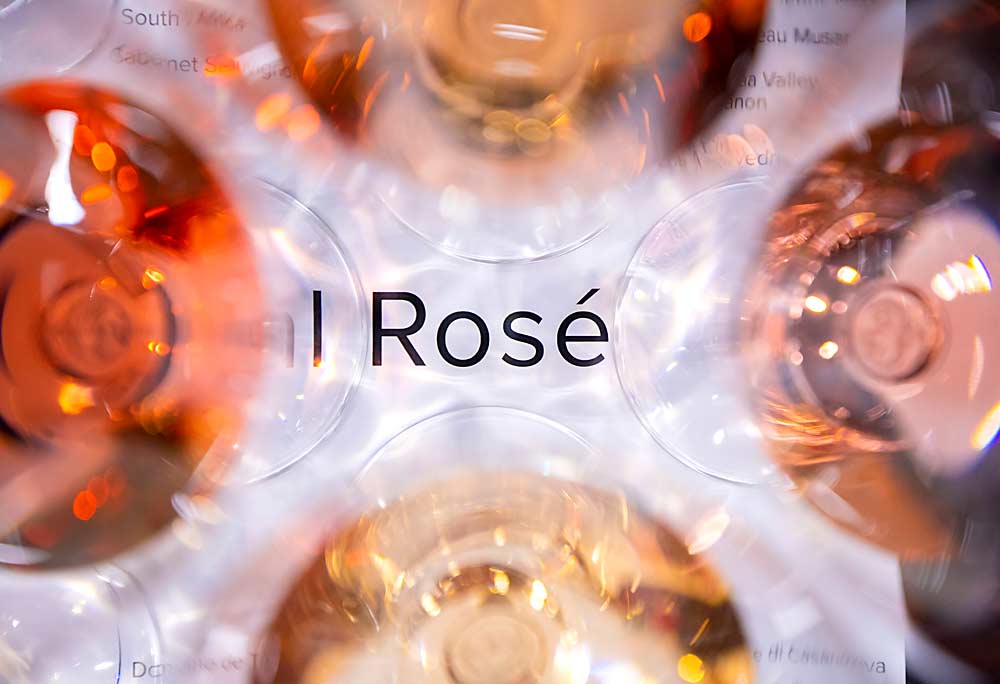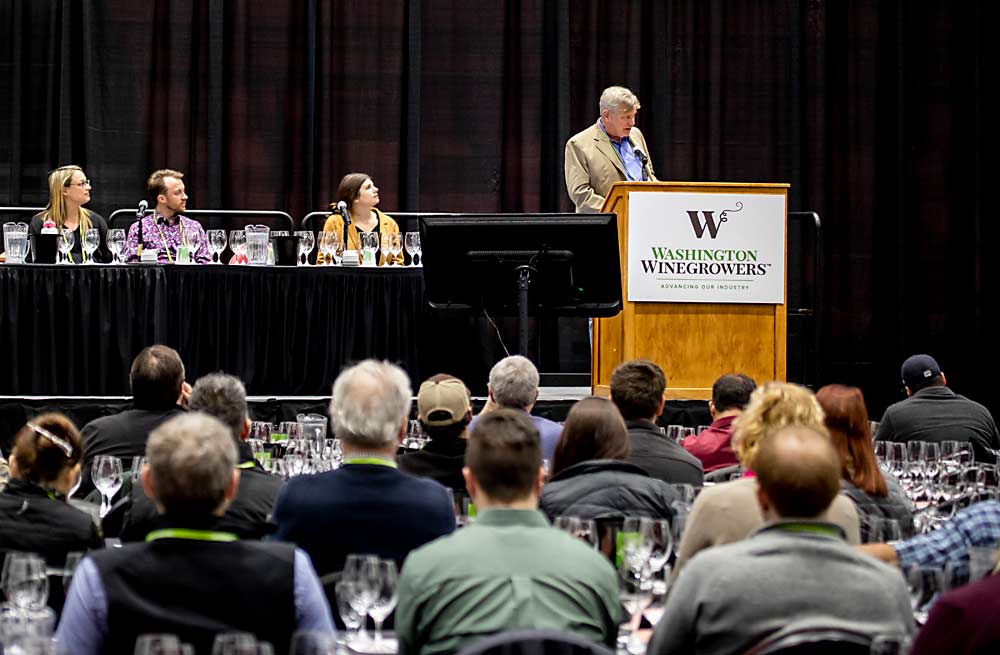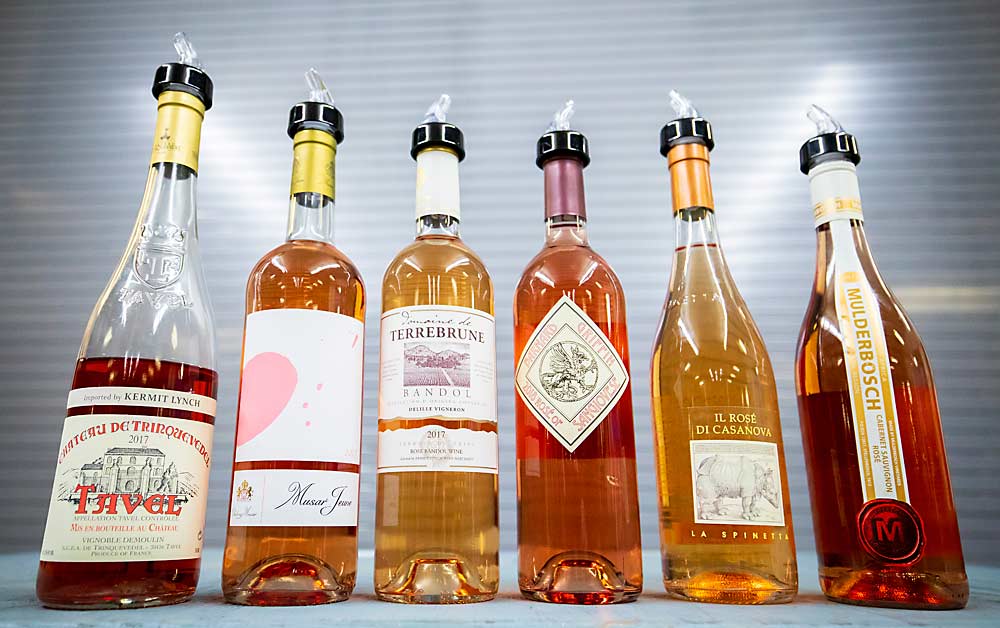
With the rosé market continuing to grow in the U.S., vineyards and wineries are taking notice by putting in more vines to meet consumer demand for the pink wine. Here, several varieties such as Sangiovese, Grenache, Cinsault and Cabernet Sauvignon show their colors during an “Intentional Rosé” tasting during the 2019 Washington Winegrowers Association convention in February in Kennewick, Washington. (TJ Mullinax/Good Fruit Grower)
Pink wine is growing into a serious market segment, not only around the world but also throughout the Pacific Northwest.
Any winery can quickly jump into the rosé category because it can be made with every red wine grape. But winemakers have found that making delicious rosé has to be intentional and it relies on careful farming, sometimes surprising crop levels, and planning that begins deep in winter.
That’s creating new opportunity for growers, as experts say rosé can sing when made from vineyards on weaker sites — by changing to management strategies more similar to Riesling than reds, aiming for higher crop loads, encouraging bright flavors and acidity, and slower ripening.
Rosé ranges in style from sweet, white Zin California Kool-Aid to the bone-dry style of Southern France’s Provence region. This fruit-driven, bright and food-friendly version is the style typically emulated by Northwest winemakers. Dry rosé, it turns out, is a versatile food wine, meant to be enjoyed under sun-drenched skies as well as at Thanksgiving.
Generally speaking, there are three ways to make rosé wine:
—Limited skin contact: Red grapes are gently pressed and the juice is allowed to remain in contact with the skins, allowing color and flavor to be extracted. This can last as little as a few hours to a day or two.
—Saignée: The method through which juice is drained off freshly pressed red wine. This has the dual effect of concentrating the remaining red wine.
—Blending: A simple way of making rosé is to add some red wine to a white wine.
While all these methods are used in the Northwest, the first, most traditional method is the most popular.
Perhaps the Northwest’s most famous rosé is crafted by Barnard Griffin Winery in Richland, Washington. Rob Griffin makes his version from Sangiovese grapes each year.
He never intended to make rosé, but a grape grower friend approached him in 2002 with some unsold fruit. Griffin had no interest in making a traditional red table wine from Sangiovese, so he decided to make a pink wine.
It was popular with his customers, so he made it again the next year, expanding production to 600 cases. He made it in a dry style, much crisper than he thought consumers would want. Turns out they couldn’t get enough, and the wine sold out more quickly each year.
As the accolades piled up and consumer demand grew, Griffin began to play around with crop levels, looking for tonnage that could help thread the tension between flavor and acidity. This had the dual purpose of increasing production while also making better wine each vintage.
After several years, he settled on 9 tons per acre as the optimal level for his program. That’s rather high tonnage, two to three times what he might target for a reserve-level wine. But that, as it turns out, provides the perfectly balanced juice he wants for his rosé.
It also means his growers make more money.
Sangiovese vines naturally seek to produce a lot of grapes, one of the reasons Italian winemakers love the variety. In 2016, the vines pushed out a lot of fruit. Griffin didn’t mind. Demand for his rosé seemed to grow with his production. That year, he made 20,000 cases of pink wine, a nervously large proportion of his total production. Once again, though, it earned top honors from judges, and consumers happily bought every last bottle.

Panel speakers Lacey Lybeck, Fred Dexheimer and Megan Hughes listen to Rob Griffin on the first day of the convention. (TJ Mullinax/Good Fruit Grower)
As Griffin has gained fame and success with his rosé, other producers have followed suit, meaning there are a number of wineries using Sangiovese for their pink wines. As a result, finding more fruit sources to grow his rosé program can now be a challenge.
Griffin typically picks around mid-September. Rather than targeting a specific number of Brix, he bases his pick decision purely on flavor and acid levels. The wine is made in stainless steel, bottled in January and released on Valentine’s Day.
“Set enough crop to get ripe fruit and higher acidity,” Griffin said. “This is where Grenache, Sangiovese, Mourvèdre, Cinsault, Barbera and the like shine. I think Bordeaux are too vegetal much of the time.”
For those making rosé, growing decisions are crucial, agrees Lacey Lybeck, vineyard manager for Sagemoor Vineyards north of Pasco, Washington.
Decisions for rosé begin during the first pruning passes in winter.
Lybeck said she will leave a few more buds than in classic red wine selections, and therefore a little bit of a higher crop load. She’ll also target portions of a vineyard with weaker soils that perhaps have underperformed.
All this is done to find vines that produce fruit higher in acidity and bursting with red fruit flavors. Then they’ll grow it as they would for white wine varieties, leaving more canopy in the fruiting zone in an effort to protect the grapes and control sugar accumulation as harvest begins. Most of Lybeck’s winemakers are looking to pick around 18 to 20 degrees Brix.
“It can be so hot at the end of August that we’re accumulating one to two Brix in a week, so that picking window for rosé is hugely important,” she said.
Most rosé grapes are machine harvested and picked in the early morning, so the fruit is still cool when it arrives at the winery. That helps the winemaker hold on to the fruit’s bright flavor and crispness, keys to a delicious pink wine.
Another important piece of the rosé-making puzzle is grape variety. In addition to Sangiovese being popular in Washington, Rhône and southern French varieties are also favored. Lybeck’s clients like Mourvèdre and Grenache, although the latter is so in demand for red wines and blends that little goes for pink wines, she said. A few of her clients, including Seven Hills Winery in Walla Walla, Washington, use Cabernet Franc for rosé.
She also grows rosé for Tamarack Cellars, as well as Trust Cellars and Three Rivers Winery, all in Walla Walla, as well as one Oregon winery.
Meanwhile, Ste. Michelle Wine Estates has jumped into the rosé market. Last fall, Washington’s largest wine producer crafted north of 100,000 cases of rosé between its 14 Hands and Chateau Ste. Michelle brands.
Katie Nelson, the company’s senior director of winemaking at Columbia Crest Winery in Paterson, Washington, says the company seeks grapes grown in marginal areas or even in vineyards with leaf roll virus. Anything that can slow ripening while still allowing development of flavor and preserving acidity until harvest in early September is good, she said.
They’ll typically look for tonnage up to 8 tons per acre, and they ask growers to farm it similar to Riesling. Nelson’s teams favor Rhône varieties Syrah, Grenache, Mourvèdre and Cinsault, though they also have used Bordeaux grapes, including Cabernet Sauvignon, Merlot, Malbec and Cabernet Franc.
She agrees that delicious and successful rosé begins with proper planning of vineyard sites and farming techniques.
“I tell people it takes intention, not afterthought, to make a truly amazing rosé,” Nelson said.

Barnard Griffin’s 2018 Rosé of Sangiovese stands alone as the only U.S.-grown wine among several international wines sampled during the panel and tasting. Each rosé presented contrasting color and flavor profiles to educate attendees about the wide range of possibilities in this wine category. Winery, variety and location listed from left: Château de Trinquevedel, Grenache and Cinsault, Tavel, France; Chateau Musar Jeune Rosé, Cinsault and Mourvèdre, Bekaa Valley, Lebanon; Domaine de Terrebrune, Mourvèdre, Grenache and Cinsault, Ollioules, France; Barnard Griffin Rosé, Sangiovese, Columbia Valley, Washington; La Spinetta Casanova, Sangiovese and Prugnolo Gentile, Casanova, Italy; Mulderbosch, Cabernet Sauvignon, Stellenbosch, South Africa. (TJ Mullinax/Good Fruit Grower)
As rosé continues to gain traction as a leading wine style in the Pacific Northwest, winemakers will work even more closely with growers to find the optimal growing styles that allow wineries to craft pink wines that compete with classic versions from Provence. •
—by Andy Perdue
Andy Perdue, editor and publisher of Great Northwest Wine and founding editor of Wine Press Northwest magazine, is the wine columnist for The Seattle Times. The third-generation Washington newspaperman lives in the heart of Washington wine country.






Leave A Comment